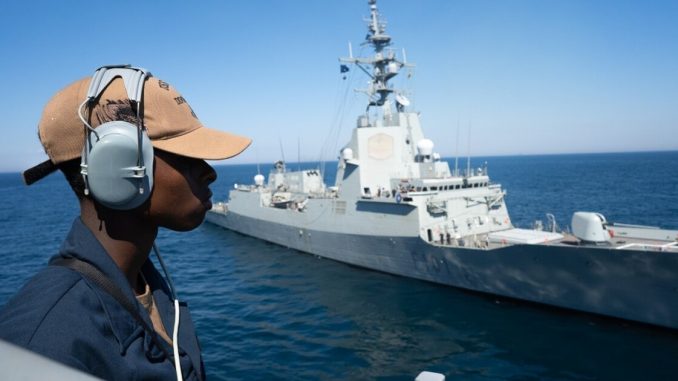
Complex joint training in the Black Sea is helping U.S. forces become better prepared for dealing with adversaries in a tense region, the U.S. Air Forces in Europe-Air Forces Africa commander said Wednesday morning.
“Conducting operations in the Black Sea ensures stability throughout the region,” Gen. Jeff Harrigian, USAFE commander, said in a statement. “Our combined presence strengthens relationships with our allies and partners while sending a message to any adversary that we are committed to collective defense and ready to respond in a complex security environment.”
Harrigian was addressing Exercise Sea Breeze. More than 2,000 troops from eight countries are taking part in the training exercise scheduled through July 26. The exercise is in its 20th iteration and includes personnel from Ukraine, Norway, Spain, Romania, Turkey, Bulgaria, Georgia, and the U.S.
The ultimate goal is to send a message to Russia, which has taken over Crimea from Ukraine, harassed Ukraine naval vessels and invaded eastern Ukraine. The region is of key interest to Russia, with that country’s only warm water ports located along the Black Sea.
Among the U.S. forces present are the guided-missile destroyer Porter and a P-8A Poseidon from Patrol Squadron 47.
“We’re excited to be in the Black Sea participating in Exercise Sea Breeze this year. It definitely gives us a strong sense of purpose and mission. And we do enjoy building relationships and developing comradery amongst our fellow allies and partners,” said Cmdr. Craig M. Trent of the Porter in a discussion with reporters Wednesday morning.
This is the Porter’s third trip to the Black Sea for joint training exercises this year.
The Porter is forward-deployed to Rota, Spain, operating in the U.S. 6th Fleet area of operations. Naval Station Rota acts as a safe haven port for 6th Fleet vessels to resupply with minimal risk of sailors contracting COVID-19.
/cloudfront-us-east-1.images.arcpublishing.com/mco/ANOR3TDMDJFVLJ4TS7CC62IJLM.jpg)
While participating troops are still able to complete the training exercises, COVID-19 has affected the way Sea Breeze is run this year.
“Historically there’s been an in-port portion of it. That’s really a great time where you can actually meet all your partners and allies and go face-to-face through the planning together,” Trent said.
Vessels participate in a variety of training missions including air defense, maritime interdiction, damage control, and search and rescue.
Among other exercises, Patrol Squadron 47 trained in anti-submarine warfare. No submarines were available for training, so troops practiced with a Mark 39 Expendable Mobile ASW Training Target, a submarine-like target that can be deployed by plane or ship.
“It really is great training for us to provide interoperability training with our sister units, allies, partners, et cetera,” Cmdr. M. Trever Plageman of Patrol Squadron 47 said of the Mark 39.
On Wednesday, U.S. Air Forces in Europe integrated the Porter into an all domain mission with assets from U.S. Naval Forces Europe, U.S. Special Operations Command Europe, and U.S. Space Command.
As part of the training mission, F-16 fighter jets stationed in Italy at Aviano Air Base practiced Joint Air-to-Surface Missile tactics. JASSMs are long-range, precision air-to-ground missiles.
MC-130J Commando II tankers from the 352nd Special Operations Wing at RAF Mildenhall, England were present to demonstrate special operations forces insertion capabilities.
Also participating were refueling air tankers stationed at RAF Mildenhall and UAVs out of Miroslawiec Air Base, Poland.
/cloudfront-us-east-1.images.arcpublishing.com/mco/FPU6ZMAGCZDPBHQFAA72K4QDTE.jpg)
In the event of a great power conflict, the Black Sea region would be a strategic location. Tensions in the region reached a high in 2018 when Russia fired on two Ukrainian naval vessels, seizing them and their crew members.
In June, the Russian Defense Ministry released footage from Russian fighter jets intercepting three U.S. aircraft over the Black Sea.
“They’re definitely present. They’re watching us. We’re watching them,” Trent said, adding that the small area of the Black Sea and Russian presence have kept troops on high alert, but that confrontation is not expected.
“Every interaction I’ve had with them has been safe and professional,” the commander said.


Be the first to comment